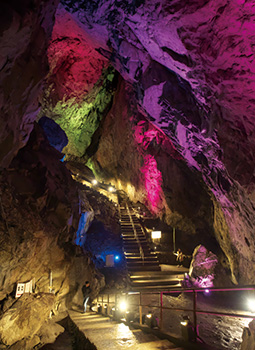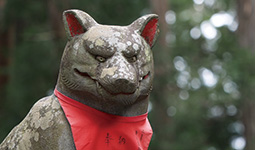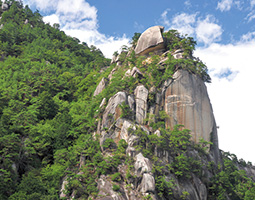Home > Highlighting JAPAN > Highlighting Japan April 2018 > National Parks
Highlighting JAPAN
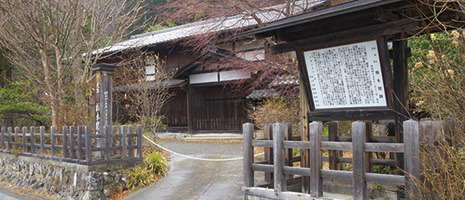
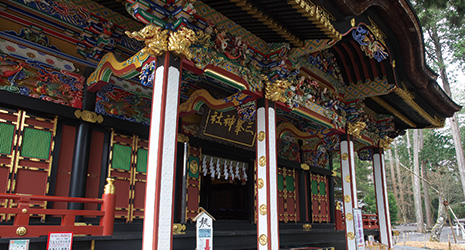
- PREVIOUS
- NEXT
Land of Mountains, Forests, Valleys and Caves
Chichibu-Tama-Kai National Park, which straddles Saitama, Tokyo, Yamanashi and Nagano Prefectures and is about 70 kilometers wide from east to west and about 40 kilometers long from north to south, is the closest mountain park of forests and valleys to the Greater Tokyo Metropolitan area.
Chichibu-Tama-Kai National Park features mountains and valleys, including the Okuchichibu Mountains that include high mountains 2,000 meters above sea level, such as Mt. Kimpu, Mt. Kobushigatake and Mt. Kumotori where Mt. Kita-okusenjodake (2,601 meters) is the highest peak, and the surrounding Mt. Daibosatsu, Mt. Ryokami, the Mitake-Shosenkyo Gorge and Okutama. Chichibu-Tama-Kai National Park is also characterized by the absence of volcanoes, although it is in a mountainous area, which is unusual in Japan. The Okuchichibu Mountains make up the headwaters and watershed of major rivers in the Kanto district and in the middle of the main island of Japan, including the Chikuma River (Shinano River), the Fuefuki River (Fuji River), the Tamagawa River and the Arakawa River. Due to the erosion of these rivers, steep V-shaped valleys have developed in the park and steep but beautiful and varied landscapes are visible. Of all the national parks, Chichibu-Tama-Kai National Park is the closest to the Greater Tokyo Metropolitan area. It attracts about 14 million visitors who enjoy contact with nature throughout the year.
From Tokyo Station, it takes around two hours to get to Hatonosu Station, which is close to Hatonosu Gorge, a spot on the eastern side of the park. The valley is about ten minutes’ walk from the station. Huge rocks and strange-looking rocks that were eroded by river currents spread to Lake Shiromaru, a dam lake 500 meters ahead. This area is known as a beautiful spot for maples. The view from Hatonosu Kobashi Bridge, a suspension bridge that overlooks the valleys, is particularly spectacular, and it is a popular spot.
Most of the eastern side of the park is a sedimentary rock area that includes strata of limestone and is dotted with limestone caves. In particular, Nippara Limestone Cave is renowned as the largest limestone cave in the Kanto district. This limestone cave is 1,270 meters in total extension and 134 meters in altitude difference. A 40-minute tour of the inside of the limestone cave leads you to a fantastic space with stalagmites and stone pillars. The inside of the limestone cave is colorfully illuminated, and a water harp poti using water that drops from the ceiling imbues it with even more mysterious charm.
In the middle and north of the park is Mitsumine Shrine, which is known as a shrine for worshipping mountains. The center of the worship is wolves, which are familiar spirits for the gods of the shrine, and wolves became the object of worship as Oinusama to the general public. The guardian god of general shrines is Komainu, a pair of stone-carved guardian dogs, whereas wolves are the guardians of Mitsumine Shrine, and wolves are enshrined in many locations in the shrine. The decorations of the main shrine (Honden) and the front shrine (Haiden) that stand in the precinct of the shrine are particularly beautiful. The main shrine hall, which was built in 1661, features copper roofing with Japanese lacquer and gorgeous colors. The front shrine of the shrine, which was built in 1800 and refurbished in 1962, features a coffered ceiling inside that depicts pictures of one hundred and several dozen varieties of flowers and trees in Okuchichibu and other colorful openwork.
On the western side of Mitsumine Shrine are the headwaters of the Arakawa River, which flows into Tokyo Bay. On the steep V-shaped valleys that were eroded by river currents are key points that connected the main roads in the Edo period (1603–1867), and Tochimoto Barrier used to be located there. This barrier played the role of securing against invasions prior to the Edo period and in keeping guard over the inflows and outflows of people and guns during the Edo period. The barrier completed its role in the Meiji period (1868–1912), but residences that were built in the late Edo period and were left within the grounds of what used to be the barrier were designated as historic sites, Places of Scenic Beauty and natural monuments in 1970 as representative of the characteristics of the houses of officials who took charge of services for the barrier. In addition, the private houses scattered over the slopes of the valleys in front of what used to be the barrier are so beautiful that they are reminiscent of the scenery in the Edo period.
Mitake-Shosenkyo Gorge, which is located in the southwesternmost part of the park, is known as a place of scenic beauty that is representative of the park. It is said to feature the greatest scenic beauty in Japan and was designated as a particularly important Special Place of Scenic Beauty among all historic sites, places of scenic beauty and natural monuments designated by the central government in 1953. Kakuenbo, which is the symbol of Mitake-Shosenkyo Gorge, is a huge rock about 180 meters tall that rises almost vertically from the water surface in the valley, and its shining white cliffs are highlighted even more by green pine trees in summer and red and yellow maples in fall. The clear stream that spreads about 5 kilometers from the Sengataki Falls at the foothills to the Nagatoro Bridge constantly shows beautiful scenes, making even rain and snow look beautiful in combination with the strange-looking rocks and huge rocks in the neighboring area and the colorful trees throughout the seasons.
Mitake-Shosenkyo Gorge has attracted numerous painters since the Edo period, and is depicted in many famous paintings. Chichibu-Tama-Kai National Park is full of such attractions, inducing visitors to post pictures of local and delicious foods served within the park as travel stories on social media, in addition to the beautiful scenery.
Note
i This is a type of Japanese garden ornament that was invented in the Edo period (1603–1867). You can enjoy the echoes of the sound of water drops that drop into a hollow bowl buried underground close to a water bowl. Please see here.
- PREVIOUS
- NEXT
© 2009 Cabinet Office, Government of Japan
